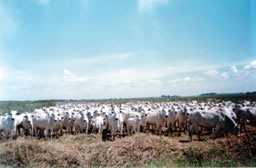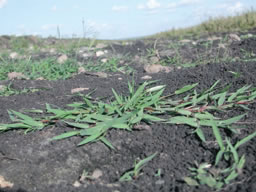On-farm trial for pasture establishment on wetland in the Brazilian savannas
Description
[Objectives]
The Brazilian savannas, which cover approximately 200 million hectares (ha) in central Brazil, are among the most important areas for livestock production in the world. It is also estimated that the savannas contain 12 million hectares of wetlands having abundant water resources which remain under-utilized. Since 1998, JIRCAS has been implementing an on-farm trial in Sao Paulo State to improve animal productivity of one of the private farms, which has 450 ha of wetland (Photo 1). In the trial, several experiments have been conducted on the wetland to select available grass species with high flooding tolerance and to pinpoint suitable seeding times for pasture establishment.
[Results]
In January 1998 (the middle of the rainy season), and November 1998 (the beginning of the rainy season), Brachiaria decumbens, B. brizantha, B. dictyoneura, B. humidicola, Andropogon gayanus, Setaria anceps and Paspalum atratum seeds were sown in wetland field plots. However, in both experiments, there was no particular species which could survive the wetland rainy season. When the grass seeds were sown in the early half of the rainy season, the small seedlings were flooded at the end of the season and could not survive. These results indicate that the suitable seeding period in the wetlands is the beginning of the dry season, when it becomes possible to use a tractor.
In related work, adult plants of B. decumbens, B. brizantha, B. humidicola, A. gayanus, P. atratum, and Cyndon dactylon were transplanted into the wetland plots in July 1999 (the beginning of the dry season) and their flooding tolerance was compared. After the following rainy season (in June 2000), it was discovered that only B. humidicola (cv. Humidicola) and P. atratum (cv. BRA-9610) had survived.
Based on those results, seeds of B. humidicola were sown on an area of 1.5 ha of the wetland in May of 2001 (beginning of the dry season), and excellent pasture establishment was observed (Photo 2). Results of this study on the private farm indicate that feeding resources can be developed by planting B. humidicola or P. atratum on the wetland pastures.
Figure, table
-
Photo 1. Grazing cattle on a wetland pasture during the dry season. -
Photo 2. Seeding establishment of Brachiaria Humidicola on a wetland pasture at the beginning of the dry season.
- Affiliation
-
Japan International Research Center for Agricultural Sciences Animal Production and Grassland Division
-
NARO Institute of Livestock and Grassland Science
The Agricultural Training Center of National Federation of Japanese Immigrant Agricultural Cooperation
Tohoku Agricultural Research Center, NARO
- Term of research
-
FY2001 (FY1997-2001)
- Responsible researcher
-
KANNO Tsutomu ( NARO Institute of Livestock and Grassland Science )
KAWAKAMI Takaji ( The Agricultural Training Center of National Federation of Japanese Immigrant Agricultural Cooperation )
YOSHIMURA Yoshinori ( NARO Institute of Livestock and Grassland Science )
UOZUMI Sunao ( Tohoku Agricultural Research Center, NARO )
- ほか
- Publication, etc.
-
T. Kanno, T. Kawakami, Y. Yoshimura, S. Uozumi and M. C. M . Macedo (2002): On-farm trial for pasture establishment on wetlands in the Brazilian savannas. Grassland Science (in press).
- Japanese PDF
-
2001_14_A3_ja.pdf884.21 KB
- English PDF
-
2001_11_A4_en.pdf106.74 KB


